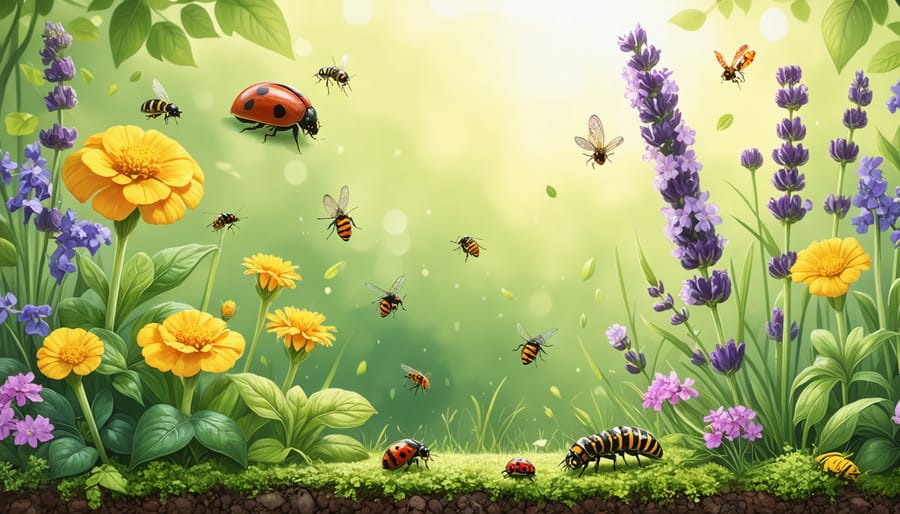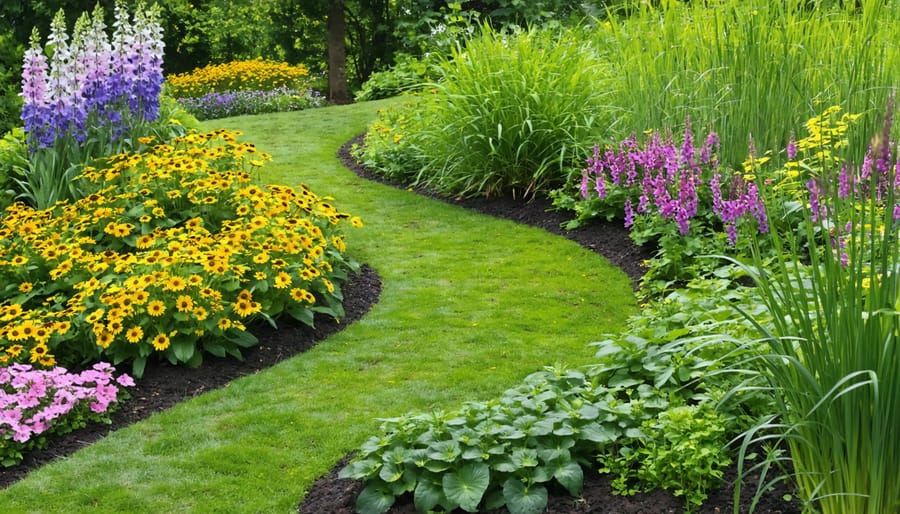Garden pests can transform your thriving perennial garden care into a battle for survival overnight. From voracious Japanese beetles skeletonizing rose leaves to sneaky aphids colonizing tender shoots, these unwanted visitors pose constant challenges for gardeners. Yet understanding these common invaders—their habits, preferred plants, and seasonal patterns—empowers you to protect your garden effectively. Whether you’re dealing with persistent slugs leaving silvery trails across your hostas or spotted lanternflies threatening your fruit trees, this guide delivers proven, eco-friendly solutions to identify, prevent, and control garden pests while maintaining the delicate balance of your garden’s ecosystem. Let’s explore practical strategies that work with nature, not against it, to keep your garden flourishing all season long.
Common Above-Ground Pests and Their Damage Signs
Aphids and Scale Insects
Among the most persistent common plant pests and diseases, aphids and scale insects can wreak havoc in your garden if left unchecked. Aphids are tiny, pear-shaped insects that come in various colors, from green to black, and cluster on the undersides of leaves and tender stems. They’re easy to spot with the naked eye, especially when they gather in large colonies.
Scale insects, on the other hand, appear as small bumps on stems and leaves, often resembling tiny shells. They can be brown, gray, or white and may go unnoticed until plant damage becomes evident. Both pests feed by sucking sap from plants, causing leaves to yellow, curl, or become distorted. You might also notice sticky honeydew residue on leaves, which can lead to sooty mold growth.
Nature provides excellent control through beneficial insects like ladybugs, lacewings, and parasitic wasps, which feast on these garden troublemakers. These natural predators help maintain a healthy balance in your garden ecosystem, making them valuable allies in pest management.

Japanese Beetles and Other Leaf-Eaters
Japanese beetles are among the most recognizable garden pests, with their metallic green bodies and copper-colored wings making them easy to spot. These voracious feeders typically emerge in early summer and can quickly turn your garden leaves into skeletal remains. You’ll notice their distinctive feeding pattern – leaves with only the veins remaining, giving them a lace-like appearance.
But Japanese beetles aren’t the only leaf-munching culprits in your garden. Keep an eye out for rose chafers, which appear earlier in the season and have tan-colored bodies, and June bugs that emerge at night. These pests share similar feeding habits, targeting the soft tissue between leaf veins.
The damage usually starts at the top of plants, working downward as the beetles feed. You might first notice them on roses, grape vines, or beans – some of their favorite plants. During peak season, typically July through August, these beetles are most active on warm, sunny days.
To identify an infestation early, check your plants in the morning when these pests are less active and easier to spot. Look for clusters of beetles and shiny leaves that reflect light through their newly created holes.
Caterpillars and Moths
Caterpillars and moths can wreak havoc in your garden, with several species being particularly troublesome. The cabbage white butterfly’s green caterpillars are notorious for creating holes in brassicas, leaving behind telltale signs of their feast in the form of irregular-shaped holes and dark droppings. Watch out for the tomato hornworm, a large green caterpillar that can strip tomato plants bare in just a few days, often starting from the top of the plant.
Cutworms are another sneaky pest, emerging at night to chew through young plant stems at ground level, causing seedlings to topple over mysteriously. The distinctive tent caterpillars create silky webs in tree branches, while feeding on leaves and potentially defoliating entire sections of your fruit trees.
Keep an eye out for the brown-tail moth caterpillar, identifiable by its white-dotted sides and distinctive orange spots. These fellows particularly enjoy roses and fruit trees, leaving behind skeletonized leaves as evidence of their presence. The fall webworm is another common culprit, creating unsightly webs at branch tips and gradually expanding their territory while consuming leaves from within their protective silk shelter.
Regular inspection of your plants, especially on leaf undersides where eggs are often laid, can help you catch these pests early before significant damage occurs.
Underground Invaders: Root and Bulb Destroyers
Grubs and Larvae
Grubs and larvae can be some of the most frustrating garden pests to deal with, primarily because they operate underground where we can’t easily spot them. These C-shaped, whitish creatures are typically the immature forms of various beetles, including Japanese beetles and June bugs.
The most common signs of grub damage include wilting plants, brown patches in lawns, and loose soil that feels spongy underfoot. You might also notice that your plants can be easily pulled up because grubs have eaten away at their root systems. Another telltale sign is increased activity from animals like moles, skunks, and birds in your garden – they love to feast on grubs!
To identify if you have a grub problem, carefully dig up a small section of soil about 6 inches deep near affected plants. If you find more than 5-10 grubs per square foot, you likely have an infestation that needs attention. The grubs themselves range from ½ to 1 inch long and have distinctive brown heads with cream-colored bodies.
Different species cause varying patterns of damage. Japanese beetle grubs tend to focus on grass roots, while May beetle larvae often target vegetable garden roots. European chafer grubs are particularly destructive as they continue feeding even during cool weather when other species become dormant.
Prevention starts with maintaining healthy soil and proper watering practices. A robust root system is your best defense against these underground invaders.

Voles and Other Burrowing Pests
Voles and other burrowing pests can wreak havoc in your garden, often before you even notice their presence. These underground troublemakers leave telltale signs that every gardener should learn to recognize. Look for narrow surface tunnels about two inches wide, sunken paths in your lawn, and mysteriously disappearing plant roots. If you spot plants suddenly wilting or toppling over, chances are you’ve got burrowing visitors.
Prevention is your best defense against these persistent diggers. Start by maintaining a tidy garden – remove dense ground cover and keep mulch at least 6 inches away from plant stems. Installing underground barriers made from hardware cloth can protect valuable plants, while burying it at least 12 inches deep with a 6-inch horizontal bend will discourage tunneling.
Natural deterrents like castor oil granules and sharp gravel mixed into your soil can make your garden less appealing to burrowers. Planting daffodils, alliums, and fritillaria around vulnerable areas helps too – these bulbs naturally repel many underground pests. Motion-activated sprinklers can startle and discourage voles during their active periods.
For existing problems, consider introducing natural predators by installing owl boxes or creating perches for hawks. Remember that while these pests can be frustrating, maintaining a balanced garden ecosystem often leads to natural pest control over time.
Natural and Organic Control Methods
Companion Planting Strategies
Companion planting is one of nature’s smartest pest control strategies. Marigolds are garden superheroes, naturally repelling aphids, nematodes, and other troublesome insects while adding cheerful color to your beds. Plant them around the borders of your vegetable garden or intersperse them throughout your flower beds.
Herbs are excellent pest-deterrent companions. Basil keeps flies and mosquitoes at bay while protecting tomatoes from hornworms. Lavender’s strong scent confuses many garden pests, and it’s particularly effective against cabbage moths and fleas. Rosemary and sage help protect carrots and cabbage from various insects.
Try planting nasturtiums as a “trap crop” – they attract aphids away from your prized vegetables while adding edible flowers to your garden. Garlic and onions are fantastic companions for roses and fruit trees, as their strong odor deters many common pests.
For a powerful pest-fighting combination, interplant aromatic herbs with your vegetables and flowers. This not only helps control pests naturally but also creates a beautiful, fragrant, and productive garden space.

Beneficial Insects
Attracting beneficial insects to your garden creates a natural defense system against harmful pests. Ladybugs, praying mantises, lacewings, and parasitic wasps are nature’s pest control experts, feeding on common garden troublemakers like aphids, caterpillars, and mealybugs.
To welcome these helpful allies, plant flowers that provide nectar and pollen, such as yarrow, dill, fennel, and marigolds. These plants not only beautify your garden but also serve as habitat and food sources for beneficial insects. Creating diverse plantings with different heights and bloom times ensures year-round support for these garden guardians.
Maintain areas of undisturbed soil and leave some leaf litter in garden beds to provide shelter and overwintering sites. Consider installing insect hotels or leaving hollow plant stems standing through winter to provide nesting spaces. Most importantly, avoid using chemical pesticides, which can harm beneficial insects along with pests.
Remember to be patient – it takes time for beneficial insect populations to establish themselves, but once they do, they’ll provide lasting, natural pest control for your garden.
Organic Sprays and Treatments
Nature provides us with numerous effective solutions for managing garden pests without harsh chemicals. One of the most popular organic pest control methods is neem oil spray, which works wonders against aphids, mites, and various caterpillars while being safe for beneficial insects.
A simple soap spray made with pure castile soap and water can effectively control soft-bodied insects. For fungal issues, try mixing one part milk with nine parts water – this solution helps prevent powdery mildew and other common plant diseases.
Garlic and hot pepper sprays are excellent natural deterrents. Crush 4-5 garlic cloves and a hot pepper in a quart of water, strain after 24 hours, and spray on affected plants. Don’t forget about beneficial insects – you can purchase ladybugs, praying mantises, or parasitic wasps to naturally control pest populations.
For slug problems, a shallow dish of beer or a sprinkle of diatomaceous earth around susceptible plants works remarkably well. Remember to apply these treatments in the early morning or evening to avoid leaf burn and maximize effectiveness.
Prevention and Long-Term Management
Garden Design for Pest Prevention
A well-designed garden is your first line of defense against unwanted pests. Start by spacing plants appropriately to ensure good air circulation, which reduces humidity and makes your garden less appealing to many insects. Consider companion planting by mixing aromatic herbs like basil, mint, and marigolds throughout your beds – these natural pest deterrents help protect their neighbors while adding beauty to your garden.
Create diverse plantings rather than large blocks of the same species. This makes it harder for pests to spread and helps attract beneficial insects that feed on garden pests. Include flowering plants like yarrow, dill, and cosmos to attract natural predators such as ladybugs and parasitic wasps.
Design raised beds with wide paths to make monitoring and maintenance easier. Install physical barriers like row covers or netting early in the season before pest problems emerge. Incorporate a mix of tall and short plants, creating natural barriers that can slow pest movement through your garden.
Remember to rotate your crops annually, even in ornamental gardens, as this disrupts pest life cycles and prevents soil-borne problems from building up over time.
Seasonal Monitoring Schedule
Regular pest monitoring is a crucial part of seasonal garden maintenance, and timing is everything when it comes to catching problems early. Start your inspections in early spring, checking newly emerging plants weekly for signs of slugs and cutworms. As temperatures warm up in late spring, increase monitoring to twice weekly, paying special attention to aphids and leaf-eating insects.
During summer months, conduct thorough inspections every 3-4 days, focusing on both leaf surfaces and stem joints where spider mites and whiteflies often gather. Look for signs of Japanese beetles from June through August, particularly during warm, sunny afternoons when they’re most active.
In fall, reduce monitoring to weekly checks, watching for signs of root-damaging pests and late-season caterpillars. Winter monitoring can be less frequent, but don’t forget to check any overwintering plants in greenhouses or cold frames monthly.
Keep a simple garden journal to track pest appearances and treatments – this will help you anticipate and prevent problems in future seasons.
Managing garden pests doesn’t have to be a constant battle with nature. By understanding the delicate balance of our garden ecosystems, we can work harmoniously with beneficial insects while keeping problematic pests in check. Remember that prevention is always better than cure – maintaining healthy soil, practicing crop rotation, and encouraging natural predators are your first lines of defense.
When pest problems do arise, start with the least harmful control methods first. Simple solutions like handpicking, barrier methods, and companion planting can often resolve issues before they escalate. If stronger measures are needed, consider organic pesticides and targeted treatments that won’t harm beneficial insects or contaminate your soil.
Most importantly, accept that a completely pest-free garden isn’t realistic or even desirable. Some insect activity is normal and can even benefit your garden’s overall health. Focus on maintaining a balanced ecosystem where pests are managed, not eliminated. By adopting these sustainable practices, you’ll create a resilient garden that naturally resists pest problems while supporting local biodiversity.
Let’s work together to protect our gardens and the environment by choosing responsible pest management strategies that future generations can proudly continue.




